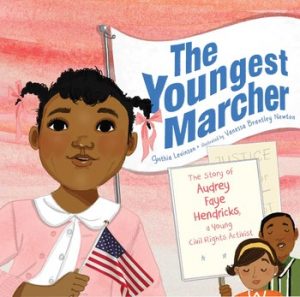 The Youngest Marcher
The Youngest Marcher
Written by Cynthia Levinson
Illustrated by Vanessa Brantley-Newton
Atheneum Books, 2017, 40 pp
ISBN: 978-1481400701
The historical narrative of The Youngest Marcher chronicles the influential mark made by some of the least expected and budding participants in the fight for desegregation. The story takes place in Birmingham, Alabama during the 1960s at the peak of the Civil Rights Movement. Audrey Faye Hendricks and her family often host dinners for Dr. Martin Luther King, Jr. and other prominent leaders who create plans of civil disobedience. Audrey, alert and ambitious, attempts to voice her consensus but is hushed often because of her age.
Audrey reflects on her wishes to have equal rights to available seats, front doors, clean water, and ice cream at open countertops as do white residents. She anxiously watches reluctant church members too afraid to join Dr. King’s call to action to fill jails to capacity. When Reverend Jim Bevel proposes children participate in the civil disobedience, Audrey volunteers to march alongside other students. To her surprise, she is one of the youngest protesters and the only one from her elementary school. Audrey is arrested on the first day and sentenced to a week in a juvenile facility. As the days go by, more young protesters are arrested, confined behind bars, and separated from their parents. The cells overflow. Although her time is unsettling, Audrey witnesses the impact the protesters have when the overcrowded jail leads to desegregated stores and restaurants.
Levinson’s The Youngest Marcher expands upon several themes related to collaboration, resilience, grit, acceptance, and equality. The message is clear: some of the smallest humans can have a great impact for positive change. In May of 1963, Hendricks, along with over 3,000 adolescents, were arrested during the Children’s March. This biographical narration also highlights the influence of civil rights leaders who inspired the actions of Audrey Faye Hendricks and young nonviolent demonstrators. Classroom curriculum often focuses on the prominent leaders of the Civil Rights Movement, and readers can browse through the pages of The Youngest Marcher and make connections to the familiar face of Dr. Martin Luther King, Jr. This rarely told story points out that numerous people were instrumental in policy changes that had long threatened and prohibited people of color from the simple joys of life. Audrey Mae Hendricks later became known as the Civil Rights Queen.
Each page is filled with vibrant freehand digital illustrations that utilize a retro style. The characters are dressed in pastels, pleats, and floral prints that create texture and imagery. Although the topic is serious and historic, the cartoon-like illustrations add a tender tone to the protagonist.
Whether The Young Marcher is a leisure read or a mentor text, it opens the door to necessary conversations on race relations in America. In order to avoid history repeating itself, children should be exposed to biographical accounts such as The Young Marcher. Readers can understand the historical context as it relates to validating all members of society. This text can be paired with Child of the Civil Rights Movement (2013), written by Paul Young Shelton and Raul Colón to analyze multiple perspectives of children living through the segregation era.
Children’s author Cynthia Levinson is known as an advocate for nonfiction literature. She writes narrative nonfiction because she wants to understand her subjects’ motivations and what propels their actions (Levinson, 2021). Her books have received numerous recognitions, including the Carter G. Woodson Award, the Jane Addams Book Award, the Crystal Kite, a Golden Kite and Orbis Pictus Honors, and The Youngest Marcher was a nominee for the NAACP Award. Her work can be explored on her website.
The Youngest Marcher‘s illustrator, Vanessa Brantley-Newton, wants all children to see their unique experiences reflected in the books they read, so they can feel a sense of empowerment and recognition (Painted Words, 2022) She has illustrated over 25 picturebooks, including One Love (2014), a board book co-authored with Cedella Marley. Her authored collection includes Grandma’s Purse (2018) and Let Freedom Sing (2022), among others. Her work can be explored on her website.
References
Levinson, C. (14th November 2021) Why I Write Narrative Nonfiction by Cynthia Levinson. http://celebratescience.blogspot.com/2021/11/why-i-write-narrative-nonfiction-by_01847587463.html
Painted Words, Inc. (2022). Vanessa Brantley-Newton. https://www.painted-words.com/portfolio/vanessa-brantley-newton/
Tamika Chandler, Arlington ISD, Texas
© 2022 by Tamika Chandler

WOW Review, Volume XV, Issue 1 by Worlds of Words is licensed under a Creative Commons Attribution-NonCommercial-ShareAlike 4.0 International License. Based on work by Tamika Chandler at https://wowlit.org/on-line-publications/review/xv-1/9
WOW review: reading across cultures
ISSN 2577-0527
